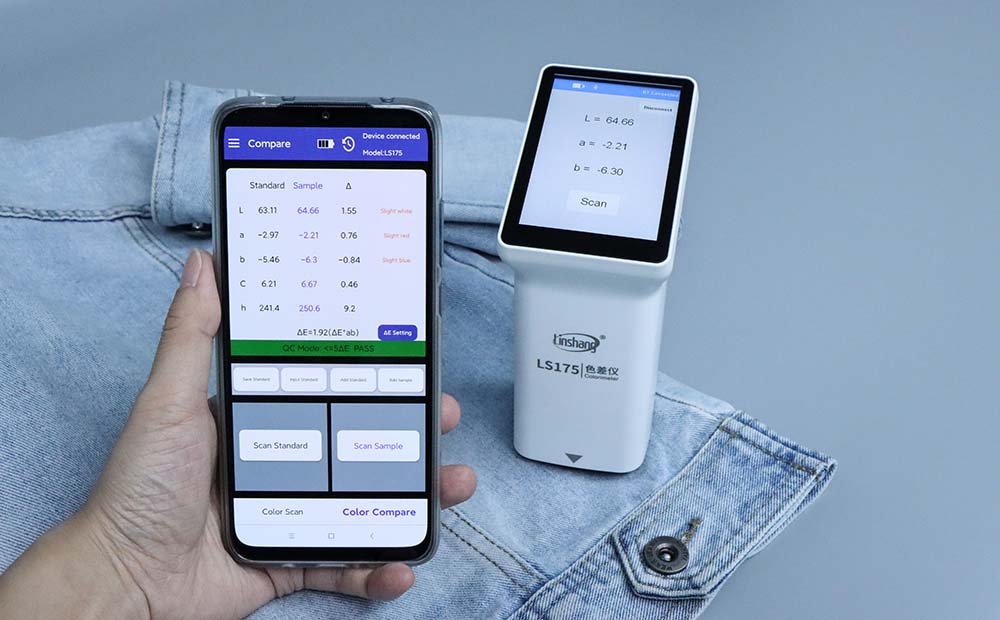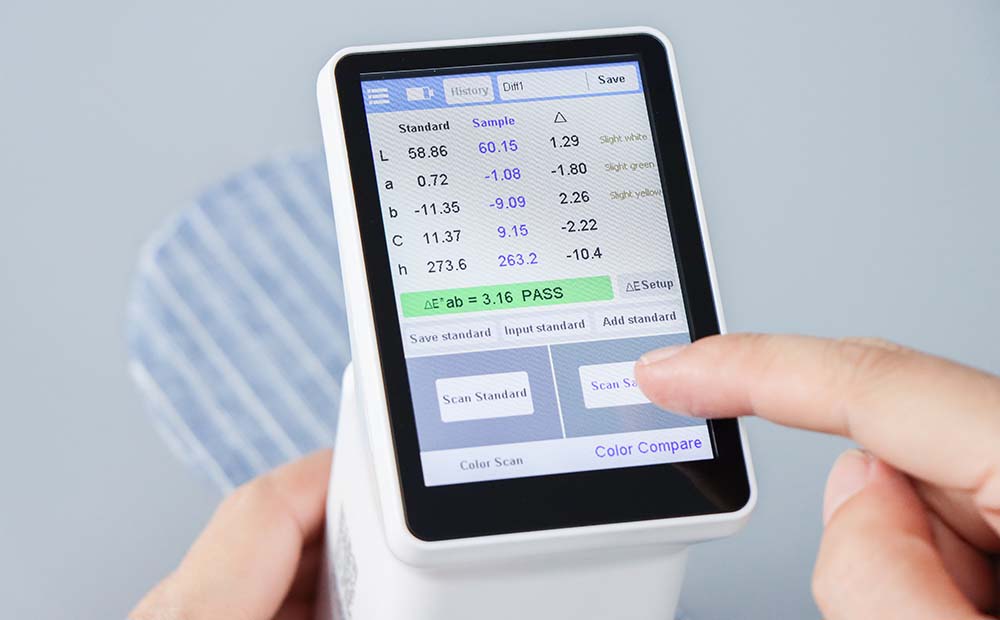How to measure the color difference with the leather cloth colorimeter?
Color difference is a very important quality index in the leather and cloth industry, mainly related to the raw material dyeing process of leather and cloth. You can use the leather and cloth colorimeter to detect the color difference between leather and cloth, and control the color difference within a reasonable range. This article will give you a detailed introduction to how the color difference of leather fabrics occurs and how to measure the color difference with a leather fabric colorimeter.

Why chromatic aberration
1. The dye is unevenly distributed on the cloth in advance
Before the dye is fixed, if the dye is unevenly distributed on various parts of the fabric, the color difference will inevitably form after the color is fixed. The main reasons for this situation are:
cloth factor
Due to the different fiber properties or the pretreatment, boiling, bleaching, and silk are not very uniform, the semi-finished products before dyeing have uneven permeability and cause differences in dye absorption.
Suction factor
Due to mechanical structural reasons or wrong operation, the liquid retention rate of each part of the fabric is inconsistent, resulting in color difference.
pre-baking factor
When pre-drying after padding the dyeing solution, due to the inconsistent drying speed and conditions, the dyes will migrate to different degrees, and the dyes will be unevenly distributed on the fabric.
2. The degree of dye fixation on the fabric is different
Although the dye is uniformly distributed on the cloth in the early stage, during the fixing process, if the conditions are not properly controlled (such as temperature, time, dye concentration, etc.), the dye on some parts of the cloth is not fully fixed. It is removed when soaping is processed, resulting in color differences. For example, the heat melting temperature of disperse dyes is inconsistent on both sides or before and after, partial reduction or oxidation of vat dyes is not in place, and poor steaming conditions of reactive dyes will cause color difference between front and back or left and right of fabrics.
3. The shade of the dye changes
This difference is not caused by the uneven distribution of dyes on the cloth, but due to some reasons that cause the color shade of some dyes on the cloth to change. Generally, there are several reasons:
Pre-dye factors
The whiteness of the semi-finished products is uneven or the pH value is quite different, which often causes the difference in color and light after dyeing.
staining factor
For example, if the thermal melting temperature of disperse dyes is too high, the shade of some dyes will become dull; the excessive reduction of vat dyes will also make the shade different.
Post-dye factors
In the post-finishing process, such as resin finishing, high-temperature tentering, and different pH values on the fabric, etc., will cause changes in the shade of the dye to varying degrees.
soaping
If soaping is not in place, the color will not be sufficient and the shade will be inaccurate.
How to detect chromatic aberration
In the traditional manual color measurement process, because each observer perceives a large change in the judgment of the color difference, and is easily affected by the light source, observation angle, surrounding environment, and the observer's own physiological and psychological conditions, it will lead to color difference evaluation. The result is not very accurate. Therefore, more and more manufacturers of leather fabrics have begun to use colorimeters to measure color.
The LS175 portable colorimeter from Linshang can be used for the colorimeter. The 20mm large-caliber ensures better consistency of measurement data. The 3.5-inch touch screen is easy to operate, equipped with Bluetooth APP and PC software for smooth data transmission, and built-in multiple electronic color cards It is also possible to establish a personal color card library, and the standard deviation △E*ab<0.03 has good repeatability.

How to use the colorimeter
1. Press the power button to turn it on, and you can choose to calibrate or skip the calibration. Frequent use of the instrument has the option to skip calibration.
2. Set the threshold of △E and select the appropriate color difference formula. In the evaluation of fabric color matching effect, the most commonly used color difference formula is CIELab; in the image-based textile field, the effect of CIE94 color difference formula is better; in the printing and dyeing industry, CMC color difference formula is generally used.
3. The △E obtained by measuring the standard and the sample respectively is the color difference. The instrument has a QC judgment function, which can automatically judge whether the color difference is qualified or not.
According to GB250 and GB251 national standard textile color card standards, the color difference standard of clothing visual color comparison is divided into 5 grades, 5 grades are no color difference, and the general first-class product color difference requirements are 4 grades (including the middle edge, the beginning and the end) but compared with the standard color There is no standard requirement for color difference, it depends on the agreement between the supplier and the buyer. The specific grade standards are as follows:
Level 5: color difference requirement is 0, tolerance requirement is 0.2; Level 4-5: color difference requirement is 0.8, tolerance requirement is ±0.2;
Level 4: Color difference requirement is 1.7, tolerance requirement is ±0.3; Grade 3-4: Color difference requirement is 2.5, tolerance requirement is ±0.35;
Level 3: Color difference requirement is 3.4, tolerance requirement is ±0.4; Grade 2-3: Color difference requirement is 4.8, tolerance requirement is ±0.5;
Level 2: Color difference requirement is 6.8, tolerance requirement is ±0.6; Grade 1-2: Color difference requirement is 9.6, tolerance requirement is ±0.7;
Level 1: The color difference requirement is 13.6, and the tolerance requirement is ±1.0;
How to prevent chromatic aberration
1. Try to use standard measurement conditions, such as preventing the sample from being transparent during measurement, taking the average value of multiple measurements, etc., to ensure the accuracy of the measurement results.
2. According to the limitations in actual production, communicate with customers about the appropriate color difference requirements
3. Continuously strengthen strict quality control, and ensure the use of standard light sources and observation conditions consistent with customer requirements when performing visual evaluation.
The above is the whole content of how to use the leather cloth color difference detection instrument. If you want to know more about the color difference meter, you can consult customer service.
- Dry Film Gauge Advantages and Application
- Choose Steel Structure Fireproof Coating with Paint Thickness Gauge
- How to Choose Transparent Acrylic Board? | Transmission Meter
- Solar Transmission Meter For Automotive Windowshield
- How to Use Paint Thickness Measuring Instrument to Identify Automotive Paint?
- Companre LS117 Optical Density Meter With Others